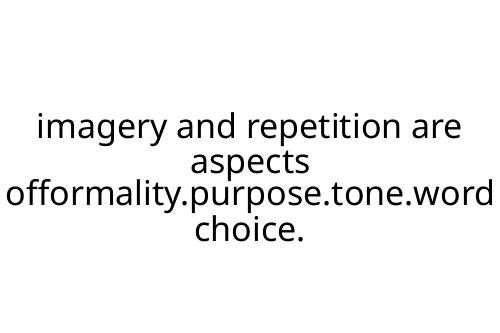imagery and repetition are aspects offormality.purpose.tone.word choice.
Imagery and repetition are aspects offormality.purpose.tone.word choice. If you’ve ever wondered how writers shape the feeling, direction, and clarity of a piece, these terms are where you start. Understanding how they work can improve your own writing—whether for school, work, or creative pursuits.
What is Imagery?
Imagery is about painting pictures in the reader’s mind. It uses descriptive language to appeal to the senses—sight, sound, touch, taste, smell. For example: “The crisp autumn wind rustled golden leaves along the empty sidewalk.” Instead of just saying it was windy, imagery lets the reader experience the scene.
Why It Matters
Imagery makes writing vivid and memorable. It grounds abstract ideas and helps readers visualize what’s happening. With strong imagery, even a simple message can become compelling.
The Role of Repetition
Repetition means using words, phrases, or structures more than once for emphasis or rhythm. Think of Martin Luther King Jr.’s speech: “I have a dream…” Each repetition drives the message deeper.
When (and When Not) to Use
Repetition can clarify an idea or make key points stick. But too much repetition comes across as lazy or patronizing. Use sparingly, and with clear intent.
How These Relate to Formality, Purpose, Tone, and Word Choice
Each term—formality, purpose, tone, and word choice—is part of a writer’s toolkit.
- Formality sets the level of professionalism or casualness. Imagery and repetition must match this. A formal report uses less poetic imagery than a novel. Repetition in formal writing should be subtle and functional.
- Purpose clarifies why the text exists: to inform, persuade, entertain, or describe. Imagery helps paint clear pictures (good for description and persuasion), while repetition strengthens calls to action or highlights key concepts.
- Tone is the attitude the writing conveys. Imagery builds tone through detail (somber, playful, serious, etc.). Repetition can reinforce tone—cheerful or urgent, for instance.
- Word Choice determines which images are possible, and how repetition lands. The right words trigger strong imagery and make repetition powerful rather than stale.
Practical Tips
- Match your imagery and repetition to the formality and purpose. Formal business email? Use both sparingly and clearly. Creative short story? Expand your options.
- Don’t overdo imagery. Too much can slow readers down or feel forced.
- Use repetition for rhythm and emphasis, but mix it up to keep things interesting.
- Always revise—read aloud to see if the imagery and repetition feel natural in context.
Pros and Cons
Pros:
- Both devices add clarity and impact
- They make writing more engaging and memorable
- Help structure arguments and persuade
Cons:
- Overuse can distract or bore the reader
- Poorly chosen imagery or heavy-handed repetition can weaken credibility
- Might not suit all audiences or purposes
Final Thoughts
Imagery and repetition are aspects offormality.purpose.tone.word choice that, when applied thoughtfully, can elevate your writing. Use them in line with your goals and audience for best results. It’s all about balance and intention.



